
Hotel in Ashgabad — is not an hotel…
Our first acquaintance with a native Ashgabad resident was really pleasant. Was it Luck or Good fortune? But let’s start at the beginning. From the first day of our business trip, we joined the team preparing the exhibition stand for the Information Ministry of Belarus, representing national book publishing at the exhibition-fair in Ashgabad, which was timed for the visit of President Alexander Lukashenko to Turkmenistan in connection with the 20th anniversary of the neutrality of the country.
We understood that we would be able to see the daily life of a certain group of Ashgabad people, to talk to them near the Belarusian and Turkmen stands. We also had our own editorial task: to become familiar with the life of the city and its residents using the method of ‘random interviews’. Walking along the streets, markets and shops, collecting impressions and sharing them with the readers. And we certainly have collected a lot of them.
…In the morning, we left the hotel Ashgabad and the bus delivered us to the Sergi Köşgi Expo Centre (translated from the Turkmen as ‘exhibition palace’). The day was cloudy and rainy. At 4pm we flagged down a car and asked, “Could you take us to the Ashgabad hotel for 10 Manats?” At the wheel was an elderly man and we had been advised of the low taxi rate in Ashgabad of 10 manats to any part of the city. We saw meters in some cars, but they were possibly just for the sake of appearance. The price remains the same unless the taxi waits for you or if you go to the suburbs, when the price increases.
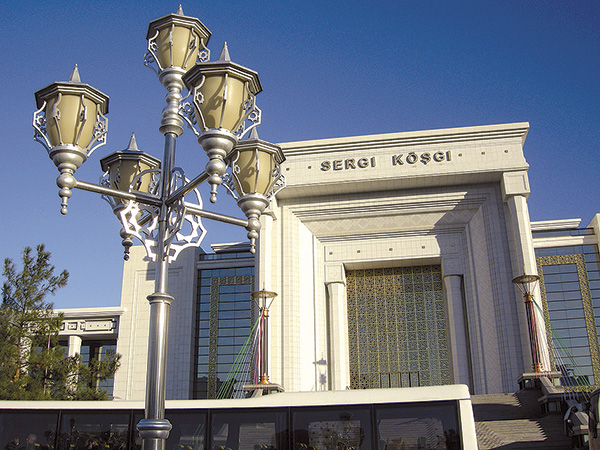
Sergi Köşgi Expo Centre is the largest in Turkmenistan and, from December
11th-13th, 2015, hosted a joint Belarusian-Turkmen trade fair
We are settling into our taxi ride, but soon, through the wet and steamy windows, we noticed that we appeared to be driving the wrong way. On the way to the centre in the morning, we were driven through wide new streets with large mansions, whilst now we could see old houses and no main streets. The driver brought us to a grey building and said, “Here we are, I have to turn around here...” We protested it was not our hotel but there on the front was its name ‘Hotel Ashgabat’. How can there be two hotels with identical names in one city? Fortunately, we had taken some pictures of ‘our’ hotel and we showed them to the driver. “You probably mean the hotel Ashgabad”, he said, “I am a pensioner and I rarely visit the new districts of the city.” It appeared he had brought us to the old hotel ‘Ashgabat’, while in the city centre there is a new hotel ‘Ashgabad Myhmanhana’. The Turkmens have managed to draw a line between the word ‘gostinitsa’ (inn) and hotel (obviously a West European modern concept). Our huge hotel towers above the city, with windows opening onto the bewitching Kopet Dag mountains with snow-covered tops, differing vastly from its ‘Soviet’ namesake. Nearby, everything is brand-new: both the Stadium Ashgabat, and the Sardar horseman monument (meaning ‘stone shoulders’) shines brightly with its golden colour surrounded by white-foam fountains, the Hotel Zvezda (Ýyldyz) and the huge matrimonial palace decorated on top with four eight-pointed stars surrounding a sphere.
We later learned that the poet Ales Badak, managed to see this palace from the inside, unusual, as it is not generally acceptable in Ashgabad to go into the local palaces. The architectural constructions in the new area of this ‘white’ city surprise visitors with their monumentalism, scope and number of high buildings reaching to the heavens, as well as their multi-coloured night time illumination. On the way from the airport, those of us who were in Ashgabat for the first time were left speechless and stared in amazement. We later learnt that recently this city, with the greatest number of buildings finished with white marble, was included in the Guinness Book of Records. 543 new buildings in Ashgabad are faced with white marble, while the total area is 4.5 million square metres!

Ashgabad Myhmanhana Hotel is a contemporary 15-storey building in the west of the city, with the capital stadium located nearby, as is Bagt Köşgi Wedding Palace
It appear that here, ‘gostinitsa’ is not a hotel at all. Our driver scratched his head uneasily: he knew that the passengers in his car were visitors from Minsk, and following the laws of eastern hospitality, it is not good to let visitors wander the streets of an unfamiliar city. He also told us that he had to pick up his architect wife on time, as she was finishing work. He asked whether we would mind going with him to pick up his wife? She knows the city better, and will help to find the hotel faster. Of course, we agreed, though we were tired after the flight, we were not in a hurry, but wanted to see the city, and talk more to our driver.
We told him he didn’t look like a native of Turkmenistan and he replied, “Yes, I am Armenian! My name is Piotr. I’ve lived here for a long time,” he smiled. “Looking at your nose, I thought that you were Armenian! My name is Valentina.” I said. Our dictaphone was already switched on, and making notes, we heard Piotr Karapetov’s laughter again. He was born in Ashgabad, grew up here, worked ‘in the transport sphere’: he travelled all over the USSR on official business and he remembers visiting Belarus. His parents moved to Turkmenistan in their ‘20s from Karabakh. Having talked about the still-smouldering conflict between Armenia and Azerbaijan, we asked cautiously whether Turkmens are tolerant and peace-loving to people of other nationalities. “There is no nationalism here,” he answered confidently. “Even the former President Türkmenbaşy had a tough attitude to displays of nationalism. His wife was a Jewess, and he understood what troubles national strife brings to people.” We remember the Ukraine, discussing the ‘overemphasis’ on nationality and language problems. Piotr, living in Turkmenistan, speaks Russian perfectly, while Armenian, the language of his ancestors, he is less confident with, his wife, who is also Armenian, knows the Turkmen language better.
Unlike other pensioners, Piotr does not plunge into politics: he is actively engaged in his health, reads, keeps himself in good shape. Every other day he has long 7-kilometre intensive jogs, does muscle-strengthening exercises including those recommended by the well-known doctor, Sergey Bubnovsky, and is attentive to his diet. This clearly works, he is a hale and hearty man, looking much younger than his 75 years. In Ashgabad there are many followers of a healthy way of life. The city has the so-called ‘healthy path’. It is a unique, lit round the clock, 36-kilometre concrete walking route in the mountains, which is 5 metres wide, with convenient places for recreation. Mass ascents along this ‘healthy road’ are organized on the International day of health, which is celebrated on April 7th. When we returned to the hotel, from the window of our room we saw this path, lit with many lamps.
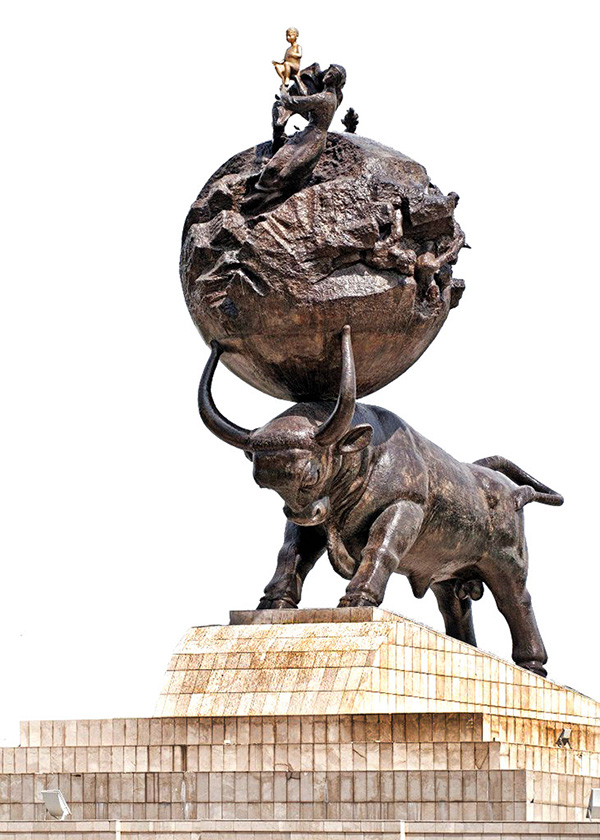
Composition in the form of a powerful bull holding a broken Earth on its horns incorporated into monument dedicated to victims of 1948 earthquake in Ashgabat
The country has strong national customs: such enemies of health as cigarettes and alcohol are outside the law. Later we saw healthy eyes, faces, skin the colour of young boys and girls. While the faces of the officials are also free from signs of the traditional bad habits. During our business trip, Turkmenistan celebrated its 20th anniversary of neutrality, solemnly, by inviting distinguished guests from different countries. Watching TV, without understanding the words, is a rather curious experience where you pay attention to the details which are usually overshadowed by the information in the speech.
Travelling through the city, at first with Piotr, and then his sociable wife Larisa, we saw the Monument of Neutrality and also, in the glow of neon lights, the largest Ferris wheel in the world with closed booths, in the entertainment complex ‘Alem’, which is also included in the Guinness Book of Records… Ashgabad also boasts Turkmenistan’s independence monument. Piotr’s wife, thankfully announced that she knew our hotel and was even present at its opening, although she said that practically every week there is something new which is solemnly opened. Having said fond goodbyes to our new acquaintances, we returned to our sparkling new hotel. As reward for our adventure, we were glad to give Piotr 10 manats (nearly $10) and also a generous tip…

36km long hiking trail through Kopet Dag mountains in Turkmenistan
is not only concreted across its full 5m width but is illuminated and has water fountains along its length
In search of braids and ‘Hottabych style’ slippers
The idea of searching for something in a story is not new: people search for matches in the film ‘Borrowing Matchsticks’, collect toast in ‘Kidnapping, Caucasian Style’, or lost treasure in the story ‘Treasure Island’, and even saviours of civilisations as in the ‘Terminator’ series. A similar theme entered into our trip. We were searching for slippers! Embroidered, with curled toes! We wanted slippers like Hottabych had, the hero of the Soviet fairy tale ‘Old Man Hottabych’ by Lazar Lagin, which the teenagers like so much. We also tried to find dried melon at the request of a good friend! Finding it became a point of honour for us, and thanks to the search for it, we met many wonderful people, it also helped us to know some people from our team much better.
We so desperately wanted to bring those slippers from the city where our friend spent his youth in the Soviet 60s and also dried braided melon seeds. Everyone we met infected us with a desire to find both things. It was remarkable to see how people responded so positively to our requests for slippers and recommended places to try next in our search. I hope our editors will forgive us, but this was an entirely romantic mission. We were extremely pleased to hear that the older generation of locals also knew of Hottabych, and we shared memories of childhood dreams of flying carpets and a magic lamp with a genie which fulfils all your wishes… It was a real miracle: Our ‘obsession’ with slippers did not do any harm to our work, on the contrary, it helped us to do it thoroughly.
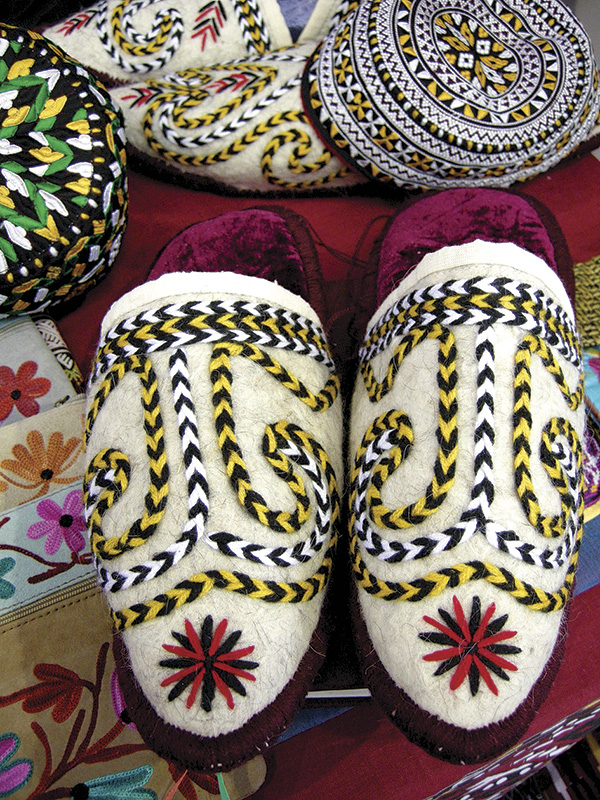
Slippers created in the national style by Turkmen masters are
a true work of art, and were on display at a stand within the joint Belarusian-Turkmen trade fair
We relied heavily on our colleague, Ales Karlyukevich [Director and Editor-in-Chief of Zvyazda Publishing House who introduced the books at the exhibition] and his Turkmen friends. On the first day of the exhibition, his friend Kasym Nurbadov, translator of works by Belarusian authors into the Turkmen language, appeared. He remembered visiting Gomel in Soviet times. In Kasym’s family there are 10 children, while the younger daughter-in-law is an academic soon she will become a reader of science and is an expert on Japan. We wondered whether someone in that big family would know where to search for the elusive slippers. Maybe this taciturn young woman could tell us, if we could only get her to talk… But, alas: Kasym had his own plans for Ales…
Questioning both Belarusians who had earlier visited Ashgabat, and local residents, including the all-knowing taxi drivers, was no use. We did learn a lot about the slippers however: these exotic goods were brought by Turkmen traders from the countries of the Arabian East and Turkey and even from India. No-one had seen the slippers on sale in the city, but they’d heard that they might be purchased at the Russian market, or in gift shops nearby. We also discovered it is possible to find any type of slippers — felt, fabric, leather — in the big flea-market Chigaldyk. But as soon as we specified what slippers we wanted, we were told that such slippers are not sold, they were delivered earlier, and that we would get lost and never find them…
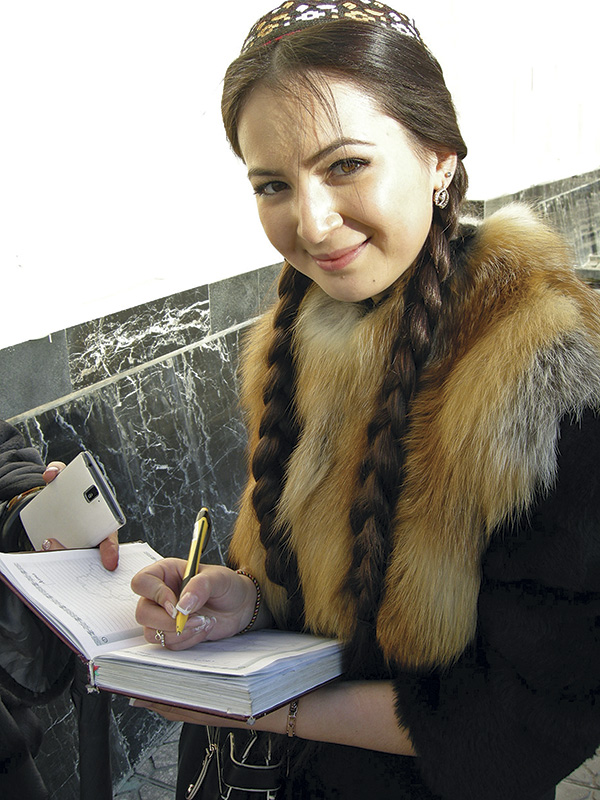
Jennet Mammedowa, a student of Ashgabat Economics University, knows where Belarus is located, as her friend studies in Vitebsk
It would have been wonderful if, during our searches, we had found a magic lamp with its genie, and a flying carpet… seriously though, modern Ashgabad is not the city from the fairy tales of ‘One Thousand and One Nights’. Our quick note dated December 9th reads, “In order to learn about the life of this city from within, it is not enough to travel through magnificent, white-golden beautiful Ashgabad. Or to walk in its palaces and shops. Everyone speaks Russian well and it is difficult to get lost. In order to look at Ashgabad closer, it’s good to spend some time in the flea market or visit the old areas of the city.”
As to maidenly braids, in Ashgabad there are a lot of them. We admired them both at the exhibition and in the street. We even talked to one owner of long and beautiful braids. Jennet Mammedowa who is a student, studying at the Ashgabad economic university. She heard about Minsk as her friend lives in Vitebsk and sometimes visits the capital. Jennet willingly posed for our camera and promised to visit the exhibition. Almost all young girls in Ashgabat wear skullcaps (they call them ‘tahya’), while married women wear ‘boric’: headdress in the form of a cone shaped turban, both officials, scientists, and actresses wear it. Pausing for a rest on our travels around the city, we began a conversation with pensioner, Oraznabat Davletova, still working as a teacher of biology. She is fond of straw weaving and invited us to school to see the creativity of her pupils, but we unfortunately had to refuse her. We suggested that, with the help of the Belarusian embassy, she might make a joint Belarusian-Turkmen exhibition of pupils’ work, having established contact with one of the schools in Minsk.
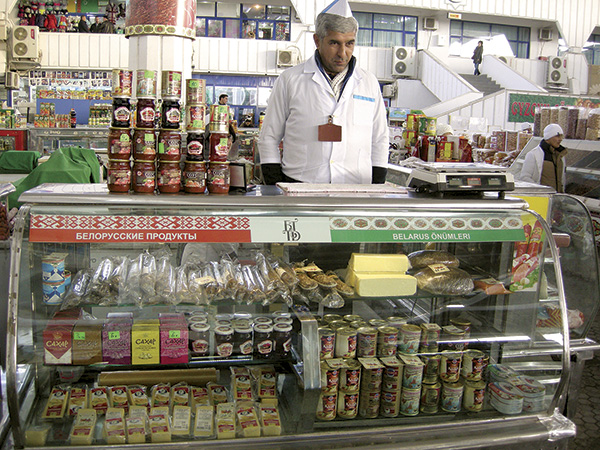
Belarusian goods are sold at Gulistan (the country of flowers) Trade Centre, including via private entrepreneur Devran
In the country of flowers and spring
On visiting the Russian market, we easily found dried melon: Vakharmanskaya me-lon, cultivated in Tychensk Region (in Turkmen –Vеlayat). The fruit is sold in the form of bars, and is nearly half a kilo in weight, in cellophane wrapping. It was possible even to buy melon chocolate. The young stallholders said that melon is not sold in long braids any more: probably it is not fashionable. but, we joked, your girls remain faithful to traditions: they still braid their hair and wear skullcaps. We photographed one seller of dried fruits and melons, while another joined in, having learnt that we are from Belarus. He told us that he will soon have exams in Mogilev as he studies by correspondence at the college, but he refused to be photographed. However, a colourful lady selling fresh vegetables and greens posed with pleasure. She, having heard that we wanted to learn the meaning of the word ‘Gyulyustan’, said that simply: ‘stan’ means country, while ‘gyulyu’ are flowers. So we visited the Country of flowers. We saw Belarusian goods too: condensed milk from Glubokoe, sugar from Gorodeya, canned meat from Bereza, conserves from the Brest company Santa Bremor. We met with the market trader Devran who has been selling Belarusian products for almost a year.
We spent a lot of time near the Russian market trying to catch a taxi. Then a young guy with a passenger in the back seat stopped at last. It appeared that we were going different ways but we introduced ourselves and got acquainted. When Bahar (‘spring’ — in Turkmen) learnt who we were, she proudly told us that just recently, she and other florists working in a huge industrial hothouse had finished making large beautiful wreaths from white and red roses for the Belarusian delegation. The next day we saw a TV news item about the visit of the President of Belarus to the People’s Memory Memorial Complex and his laying of the wreath on the monument to the fallen in the Great Patriotic War.
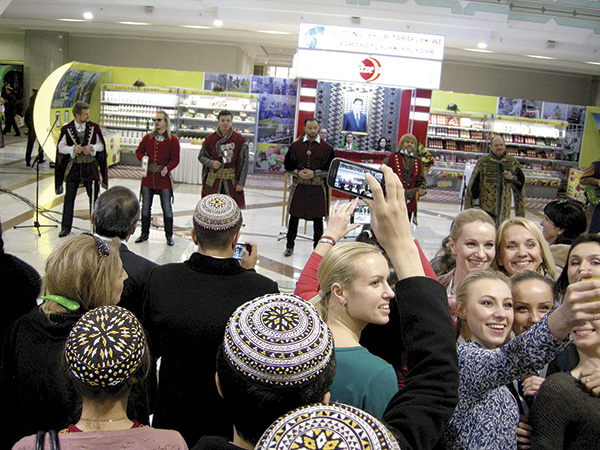
Famous Pesnyary band performed on the opening day of the joint Belarusian-Turkmen trade fair, at the Sergi Köşgi Expo Centre, inspiring girls to take a great many ‘selfies’ with the singers
Several hours before the opening of the exhibition, we bypassed all Belarusian and Turkmen stands and searched for slippers, again… There were a lot of goods from Belarus: products, furniture, gas cookers, wall-paper, toys… while outside we saw cars, truck cranes, unmanned air vehicle, tractors and cotton-picking machinery. Near our Ministry of Information stand was the Ministry of Education, where during all three days of the exhibition were a number of young people. Interest in the educational system of Belarus among the pupils of Ashgabat is huge. Neighbors told us how the young people asked in detail about the entry requirements for Belarusian colleges and universities. And after that they came to our stand: to look through the books issued by the Zvyazda Publishing House, the Petrus Brovka Belarusian Encyclopaedia, the Narodnaya Asveta. The people of Turkmenistan respect books, and describe themselves as one of the most well-read nations in the world. Many people asked whether we were selling books. Teachers wanted to buy text books, parents, fairy tales for children, housewives, books of recipes, and there were also those who were interested in Belarusian cuisine.
Postcards with draniki (potato pancakes) recipes were all sold on the first day of the exhibition. A special issue of our magazine devoted to Belarusian-Turkmen co-operation had been prepared for this event. On its pages were publications about the meeting in Minsk of President Alexander Lukashenko and President Gurbanguly Berdimuhamedov, about the construction of the Garlyk Mining and Processing Plant, and Turkmenistan’s help in the post war restoration of Minsk, as well as articles about a young ballerina from Ashgabat, Pervana Myradova, who has recently been accepted into the ballet troupe of the Bolshoi Theatre of Belarus.
It was so nice to give our magazine to visitors, knowing that they will find a lot of interesting information in it. It was also pleasant to see the President of Belarus who, together with Turkmen friends, stopped near our stand. Here the Minister of Information, Lilia Ananich, presented the Deputy Prime Minister of Turkmenistan with the book of Gurbanguly Berdimuhamedov which was published in the Belarusian language under the publishing programme of the Ministry of Information. In the book, the President of Turkmenistan describes the life of his grandfather, a rural teacher.

Education Ministry stands join those of Belarusian higher educational establishments at joint Belarusian-Turkmen trade fair at Sergi Köşgi Expo Centre, receiving much attention and praise, since parents are eager to send their children to study in Belarus
In the Turkmenistan ‘part’ of the exhibition we saw stands with souvenirs: it was possible to buy items made from stone, carpets, costume jewellery, magnets with views of Ashgabat and Akhal-Teke-fast horses, the pride of the Turkmens. We tried tasty ayran, and tea made with herbs from the high-mountains. At one of the stalls we bought walnuts in honey. While nearby — it was a real miracle! — we saw ‘old-fashioned melons’ in the form of long braids. Unfortunately, the seller was absent and didn’t return in the following days of the exhibition.
On one of stands with carpets and other treasures, we saw small felted slippers, embroidered with bright braid, with curled toes. We were so happy! We asked for slippers in a larger size, sewn to order. The highly skilled worker had made them by the next day! Though not absolutely the same as Hottabych had, but with a coloured strip which is called ‘aldzhala’ — it is a charm of the Turkmens helping to turn away the evil eye and avoid greed. Nearby we talked to Batyr Meredov: a modest man who has studied in Brest and married Belarusian Maria; his brother lives and works in Baranovichi.
Time and again during our travels we realized what a small world it is: everywhere we meet people somehow connected with Belarus. And if one of these people speaks enthusiastically about it, it makes us overflow with pride.
By Ivan and Valentina Zhdanovich
Minsk-Ashgabat-Minsk
Minsk-Ashgabat-Minsk











